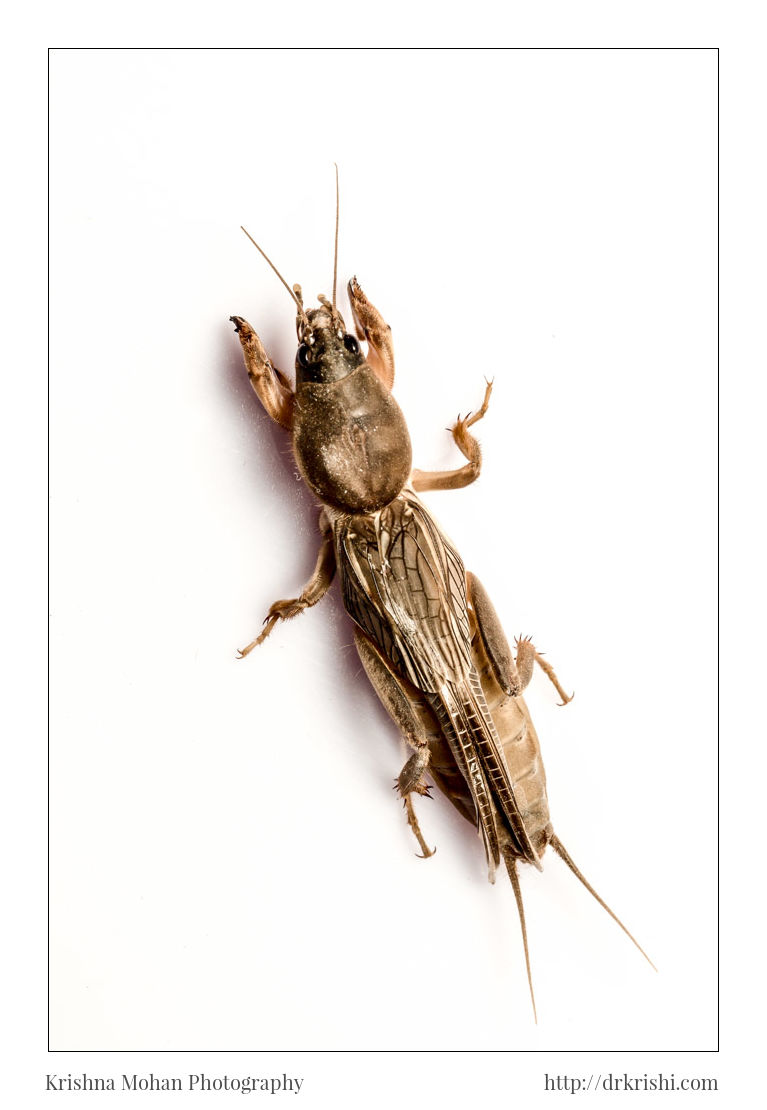
I was curious about the intermittent scratching sound coming behind the cupboard in my clinic. Expecting a pesky rat, I started poking around its corner. What came out was this oriental mole cricket. It was confused, sort of stunned and unhurt. Since the hospital surrounding would have looked odd for this mole cricket in a photo, I pushed a sheet of white paper under it and photographed using Canon EOS 5D Mark III with a Canon EF 100mm f/2.8L Macro IS USM fitted Godox Ving V860c E-TTL Li-ion Camera Flash. I used another sheet of white paper as diffuser as I did not have any soft box handy at that time. Once it realized that it is safe from this camera wielding human, it started running all around the room making its characteristic sound (check this video for its sound https://youtu.be/Y66UwxssyOg). It was pretty difficult to contain free running mole cricket on a sheet of white paper. As I did not want to stress it out, after shooting few record shots, I left it to burrow and enjoy in my garden.

Gryllotalpa orientalis is a species of mole cricket in the family Gryllotalpidae, commonly known as the oriental mole cricket. It is found in much of Asia and also in Australasia. Some consider it as a polyphagous pest, damaging crops by gnawing their roots. This mole cricket is plump, yellowish-brown, paler beneath and about thirty millimetres long. It has short filiform antennae, forelegs designed for digging and a large oblong pronotum. As with other mole crickets in the genus Gryllotalpa, the tibia of the oriental mole cricket has four dactyls (fingers). There is a row of five spines on the upper margin of the tibia of each hind leg. In the oriental mole cricket, the ocelli are elliptical, and the ocellar-ocular distance is less than the ocellar length.

The wings project slightly from beneath the forewings. After mating underground, the female builds a nesting chamber deep in the soil and lays about two hundred oval eggs which hatch after ten days. The nymphs remain in their nest for the first two or three weeks, guarded by the female. A newly hatched nymph has a blueish-white prothorax and legs. Later instars are grayish-black with white markings and the last nymphal stage is similar to the adult and exhibits short wing pads. The whole life cycle lasts for one to three years depending on the climatic conditions. The adults and later instar nymphs spend the winter underground at a depth of about a metre.

The oriental mole cricket lives underground in damp soil, digging a network of passages. Its natural habitat include damp rich soils such as flood plains and the banks of streams and ponds as well as arable land and gardens. The burrow has vertical and horizontal passages and may be complex in structure, with different parts being used for different purposes. The mole cricket feeds on the roots of plants, tubers and rhizomes and also on insects, earthworms and other invertebrates. It comes to the surface and undertakes flight in the evenings and at night and is attracted to light sources. Besides birds and insectivorous mammals, its natural enemies include ants which feed on the eggs, beetles which eat the larvae, nematodes and mites.


Nice write up with very clear good photos Doc.